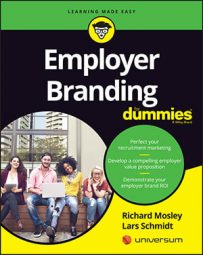This presents organizations with the opportunity to amplify employee participation in a positive engagement cycle, by stimulating, curating, and sharing employee generated content (EGC), such as images, videos, and insights. In addition to supporting internal engagement, EGC also has the potential to provide the rich flow of authentic, social content that has become increasingly vital to external recruitment marketing.
Content generation and engagement, traditionally relegated to marketing, sales, and customer service, are increasingly being distributed throughout organizations via services and technologies such as social customer relationship management (social CRM) — a sort of Facebook for business. (For more about social CRM, check out Social CRM For Dummies, by Kyle Lacy, Stephanie Diamond, and John Ferrara [Wiley].)
In the future, you can expect social media and social networking to play an ever-increasing role in branding as the walls separating organizations from customers, employees, job candidates, and others begin to come down.Facilitating employee-generated content with the right technology
Organizations can approach EGC in any number of ways, from structured approaches with tools that make specific content recommendations to employees, to unstructured ways where employees are sharing “in the wild.” Tools such as QueSocial allow you to share preselected content with employees for them to share as they see fit. They often have a gamification layer to incentivize sharing. The other end of the spectrum, giving employees creative license, requires no tools but can lead to challenges identifying and amplifying content, not to mention potential legal and exposure concerns.The sweet spot varies depending on factors including industry, regulation, and social adoption, but it’s typically somewhere between the two extremes. If you over-engineer EGC, the end result will feel like corporate speak and miss the mark on the candidates you’re trying to influence. Adding “guard rails” around sharing so employees know where they can’t go is usually the best approach.
One of the more common practices in EGC is to have employees use a common hashtag (such as #HootsuiteLife). Employees can then share content however they’d like, using whatever platform they’d like, and still be easily found and amplified by the employer brand team. Tagboard is a great tool that can aggregate hashtag-based content on a unified page. This then becomes an asset you can use to show candidates what it’s like to work there, not just tell them.
Developing policies for your employer brand to prevent misbehavior and mishaps
Having a social media policy is an important component of EGC. Without one, you risk losing control of your employer brand or potentially finding yourself in litigation. Assume common sense and good intent, but be clear about any behaviors or actions that are strictly prohibited.Companies that are successful with EGC generally provide training, guidance, and tools to help their employees understand social media platforms, video editing, blogging, and so on. Several workshops can pay massive dividends if you’re equipping your employees to develop compelling content for you.

